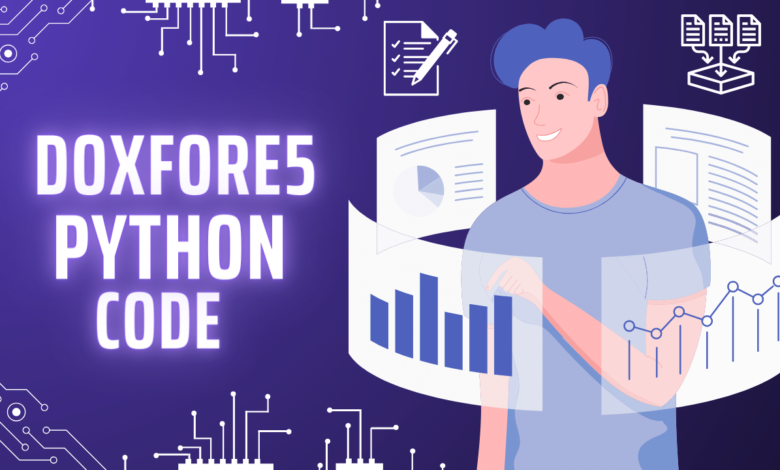Unlocking the Power of Doxfore5 Python Code: A Comprehensive Guide

In the dynamic field of data analysis and natural language processing (NLP), Doxfore5 Python code has become a potent instrument, transforming how we manage and interpret text data. Whether you are:
- A novice coder or an experienced developer.
- Understanding Doxfore5 can significantly enhance your capabilities in text analysis.
- Machine learning.
- Artificial intelligence.
This article explores the multifaceted features of Doxfore5 Python code, its practical applications, and how to use it in your projects effectively.
What is Doxfore5?
Doxfore5 is a versatile platform designed for advanced text analysis and natural language processing tasks. It leverages Python’s robust libraries and frameworks to provide a full range of instruments that enable data cleaning, transformation, visualization, sentiment analysis, named entity recognition (NER), and more.
Key Features of Doxfore5 Python Code
Text Preprocessing
Text preprocessing is the foundation of practical text analysis. Doxfore5 excels in this area by providing tools for:
- Tokenization: Splitting text into an array of tokens or words.
- Stemming and Lemmatization: Reducing words to their base or dictionary forms.
- Stop Word Removal: Filter out insignificant words like “a” and “the.”
Sentiment Analysis
Sentiment analysis is crucial for understanding the emotional undertones in a piece of text. Doxfore5’s sentiment analysis module can gauge the genuine emotions underlying statements, making it invaluable for customer reviews and social media monitoringapplications.
Named Entity Recognition (NER)
NER identifies and categorizes entities like names, places, and organizations within text data. Doxfore5’s NER function enhances the depth of text analysis by accurately recognizing these entities, essential for extracting information from sources such as news articles and legal documents.
Machine Learning Integration
Doxfore5 supports many machine learning algorithms and techniques for classification, regression, clustering, and reinforcement learning. Integrating popular libraries like TensorFlow and Scikit-learn facilitates building and training machine learning models .
Scalability and Performance
Designed to handle both small and large-scale text analysis tasks, Doxfore5 is optimized for performance. Its scalable architecture ensures efficient processing of extensive datasets without compromising speed or accuracy.
Practical Applications of Doxfore5 Python Code
Doxfore5 Python code is adaptable to various real-world applications, making it a flexible instrument for a range of domains:
Healthcare
In the healthcare sector, Doxfore5 can extract valuable medical information from clinical notes, aiding patient care and medical research. For instance, it can identify medical conditions, treatments, and patient details from unstructured text data.
Marketing
Marketers can use Doxfore5 to analyze customer feedback and reviews, gaining insights into consumer sentiment and preferences. This information is critical for shaping marketing strategies and improving customer satisfaction.
Journalism
Journalists and media organizations can leverage Doxfore5 to summarize news articles and extract critical information. This helps efficiently manage and analyze large volumes of news content.
Legal Sector
In the legal domain, Doxfore5 can assist in keyword discovery and information extraction from legal documents, facilitating legal experts’ rapid discovery of pertinent information.
Getting Started with Doxfore5 Python Code
Setting Up Your Development Environment
To start coding with Doxfore5, you need to set up your development environment:
- Install Python: Download and install Python from the official website.
- Choose an IDE: Select a code editor or Integrated Development Environment (IDE) like Visual Studio Code, PyCharm, or Sublime Text.
- Check Python Installation: Verify the installation by checking the Python version using the terminal command python –version.
Installing Necessary Libraries
Doxfore5 may have specific Python libraries that need to be installed. Use pip to install these libraries, following the instructions in Doxfore5’s documentation. Standard libraries include Pandas, NumPy, Matplotlib, NLTK, SpaCy, TensorFlow, and Scikit-learn.
Writing Your First Script
Start by writing a simple Python script to ensure your setup is correct. Below is an example of a basic script that performs text preprocessing using NLTK:
Advanced Text Analysis with Doxfore5
Once comfortable with basic text preprocessing, you can delve into more advanced features like sentiment analysis and NER using Doxfore5. Here’s a snippet demonstrating sentiment analysis:
Exploring Named Entity Recognition
Doxfore5 provides an efficient module for named entity recognition that simplifies the task. Here’s how you can use it:
Community and Support
One of the strengths of Doxfore5 is its vibrant community. Users can access comprehensive documentation, tutorials, and active support channels to enhance their understanding and usage of the platform. Regular updates and a collaborative community ensure that Doxfore5 remains at the forefront of text analysis technology.
Conclusion
Doxfore5 Python code is a game-changer in text analysis and NLP. Its rich feature set, integration with powerful Python libraries, and adaptability to various applications make it an essential resource for data analysts and developers. By harnessing the capabilities of Doxfore5, you can unlock profound insights from textual data, drive judgments based on data, and maintain an advantage over competitors.
FAQs on Doxfore5 Python Code
What is Doxfore5?
Doxfore5 is a comprehensive platform designed for advanced tasks, including natural language processing (NLP) and text analysis. It leverages Python’s robust libraries to offer tools for data cleaning, transformation, visualization, sentiment analysis, named entity recognition (NER), and more.
How does Doxfore5 handle sentiment analysis?
Doxfore5 uses its sentiment analysis module to evaluate the emotional tone of the text, making it helpful in analyzing customer reviews, social media posts, and other sources of feedback.
What is Named Entity Recognition (NER) in Doxfore5?
NER in Doxfore5 involves identifying and categorizing entities such as names, places, and organizations within the text. This feature is crucial for extracting meaningful information from documents, news articles, and other text sources.
Can Doxfore5 handle large-scale text analysis tasks?
Yes, Doxfore5 is designed to be scalable and can efficiently process large datasets, making it suitable for extensive text analysis tasks without compromising performance).
What support resources are available for Doxfore5 users?
Doxfore5 has a vibrant community offering extensive documentation, tutorials, and support channels. This enables consumers to stay current on the newest advancements and effectively use the platform.
What are the system requirements for using Doxfore5?
Doxfore5 is compatible with Python 3. x. It is essential to ensure your development environment is set up with the necessary libraries and tools for optimal performance
You May Also Read: The Ultimate Guide to VC7774: Empowering Tomorrow’s Technology Today




